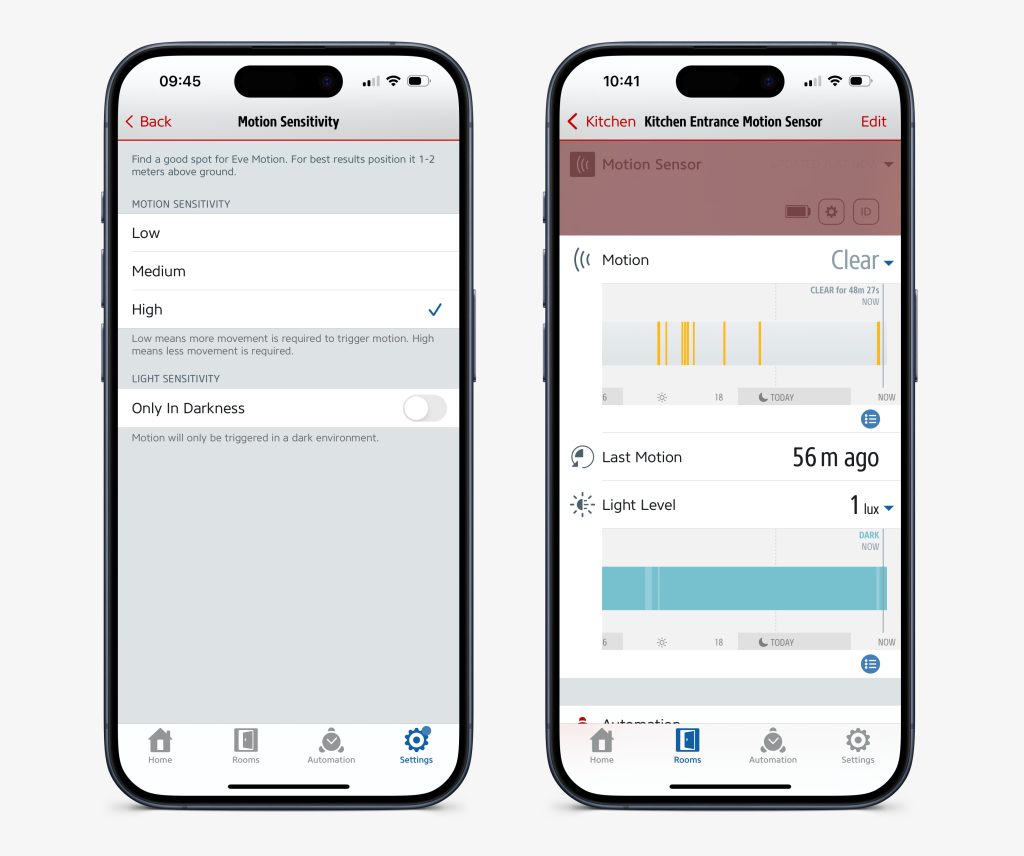
After embracing HomeKit in a big way starting in 2022, and testing several motion sensors in the intervening months, my recommendation for best HomeKit motion sensor is the Eve Motion.
The Eve Motion sensor connects directly to the Home app on your iPhone, triggers HomeKit automations quickly in response to motion events, and has a very reliable connection in my experience of many months of real world use.
Decent motion sensing range
According to the official tech specs, the Eve Motion sensor is rated to sense motion with a 120-degree field of view, up to 9 meters away. Achieving theoretical maximum range probably depends on your environment. I have mine positioned on the floor tucked under a cabinet, pointing outwards into the room. I find that I get a reliable detection radius at about 5 meters away, which I think is perfectly fine for most home needs and comparable to other Infrared motion sensors I’ve tested. The big win over the competition is the speed; via Thread, Eve Motion reports motion events near instantaneously.
I would note we are on the cusp of ultra wideband motion sensors coming on to the market, which can detect much smaller amounts of movement at much further distances, but a fully-packaged independent UWB HomeKit sensor just isn’t readily available yet. If you are interested in this and are feeling adventurous, check out the Aqara range.
Bonus light sensor
As a good HomeKit citizen, you can set up and use the Eve Motion inside of the Apple Home app, ignoring Eve’s own app altogether. But if you do have the Eve app installed, you can configure some additional settings (motion sensitivity / duration) and see a historical chart showing tracked sensor events over time.

Along with motion, the accessory also reports lux light levels, also exposed to HomeKit. Inside the Eve app, there’s a handy setting for automatically enabling the motion sensor “only in darkness”. This built-in option is very convenient as it removes one layer of complexity from your automation configurations, if you intend for the sensor to only activate lights, for example, at night time.
Solid Bluetooth and Thread connectivity options
Eve Motion supports the Thread networking protocol, the future-proofed recommended standard for smart home accessory communication over HomeKit or Matter. By default, Eve Motion can communicate motion events to HomeKit using Bluetooth. But if you have a modern Apple TV or HomePod with a Thread radio inside, it will automatically use that instead.
You can theoretically use an Eve Motion with just your iPhone, but that is much less reliable (as is the case with almost any Bluetooth HomeKit accessory). It works best when the sensor is static and in range of a HomeKit hub, like an Apple TV or HomePod. In that configuration, the motion detected state is shown in the Home app within a few hundred milliseconds of motion occurring. I also have never had the Eve Motion enter a “not responding” state. It never needs to be reset.
Long battery life
Eve Motion is powered by two internal AAA batteries. But the best part is you won’t have to worry about replacing the batteries often. For about a year so far, my primary Eve Motion has been active in situ in the home kitchen, detecting human occupancy multiple times a day. It shows no signs of running out of juice, currently reporting 90% battery remaining. I wouldn’t be so bold as to suggest this means it will go on to last ten years on a single set of batteries, but clearly the battery life longevity is more than fit for purpose.
Eve Motion is my recommendation
So if you are looking for a HomeKit motion sensor, these factors combine to make Eve Motion my recommendation. It’s even able to be used outdoors, thanks to its mounting hook and IPX8 water resistance rating.
The real question before you buy is do you have a use case for a motion-activated smart home, in the first place? If you just want to get a banner notification on your phone when someone enters a room, the Eve Motion can do that. But the real value is unlocked when used in automations in coordination with other smart home accessories, like being able to turn lights on for you. Getting them to sing also butts up against some of the limitations of HomeKit itself, so you need to be prepared to dive deep if you want to maximise their utility.
Runner up: Philips Hue motion sensor

The Philips Hue motion sensor is a good alternative. In fact, it’s a bit smaller than the Eve Motion, and integrates a magnetic mounting system, so it can probably be positioned even more discreetly in a room. It responds fast to input, if not quite as speedy as Eve over Thread, and has comparatively long battery life. However, the big downside to the Hue sensor is it is not an independent accessory. It must be connected to a Phillips Hue bridge hub in order to connect to HomeKit. If you already have an ecosystem of Hue devices in your home, then go for it. But if you don’t, it’s just not worth the additional hassle and expense.
FTC: We use income earning auto affiliate links. More.




Comments